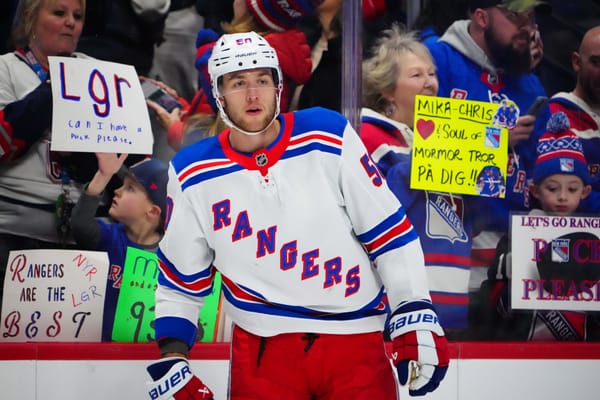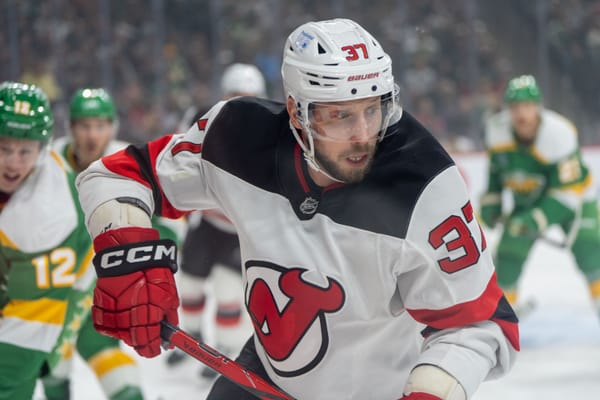Coaching to Blame for Game Two Loss to Canadiens
With approximately 11 minutes and 13 seconds left in the third period of last night’s game in Montreal, defenseman Brendan Smith headed to the Rangers’ bench for a change. Nine seconds earlier, Brady Skjei did the same. The pairing had been having a very good game up to that point, limiting the Habs’ offensive zone time while driving play forward for the Rangers.
Here are the shifts the two had over those final 11 minutes and 13 seconds (data via Shiftchart.com).
In the final 11:13 of the third period, with the Rangers clinging to a one-goal lead, the duo played two minutes. In the final 5:50, they played 49 seconds.
This is the kind of usage that Chicago’s Joel Quenneville employed in 2015 for an underwhelming third pairing in favor of quality shutdown defensemen like Duncan Keith, Nicklas Hjalmarsson, Brent Seabrook. For Head Coach Alain Vigneault and Assistant Coach Jeff Beukeboom, he glued his best performing defensive pair of the game to the bench in favor of a Marc Staal/Nick Holden pairing that had struggled all game, allowed too many zone entries, lost assignments, and ultimately bled shots on their way to conceding two goals. It was this pairing that Vigneault would rely on down the stretch, playing them for virtually half of the 4:12 that preceded Radulov’s tying goal, which they were on the ice for; their third goal of the game conceded.
There’s an obvious disconnect going on between the coaches and the reality of who was playing well last night and, presumably, who had the best chances of shutting down Montreal’s attack. Even by the most optimistic view of Holden and Staal, there’s no rational argument to be made for not at least giving Skjei and Smith a regular shift.
There is also the bigger picture disconnect between the front office’s evaluations of incoming players and how the coaching staff is using them. Over the previous one-and-a-half seasons, Keith Yandle was used in a third-pairing role after the Rangers broke the bank to acquire him. Yet again, the Rangers gave up considerable assets they could only barely afford to part with purely for the sake of acquiring Smith’s ability to play shutdown minutes. Yet, in the ten most important defensive minutes of the entire season, Smith was nowhere to be found.
If Vigneault does not trust Smith in these situations, it goes against all logic, but so be it. But if that’s the case, what was the point of acquiring him in the first place? Why are the Rangers continually making big investments that are not congruent with how the coaching staff rates those players?
This is the most obvious knock against the coaching staff from last night’s game, but there’s a bigger team-wide issue as well. The Rangers once again resorted to shelling. In the third period, the Rangers were out-attempted 33-to-11. Over the final 10 minutes of the game, the puck was in Montreal’s zone for a total of two minutes and 38 seconds. That’s just the puck being physically located in the zone; never mind Rangers’ possession of it. The Rangers gave up on establishing a forecheck of any kind, much less generating offense. It’s a strategy that has been defended in years’ past because of the Rangers’ record while protecting leads. It no longer can be brushed off. The Rangers had only the 16th-best win percentage in the NHL this season when scoring first, 16th-best win percentage when leading after one period, and 11th-best win percentage when leading after two.
Sitting back on leads has been actively detrimental to the Rangers this season, and it burned them in a big way last night. The players of course contributed to this, but this is also a group that showed all season long they could generate offensive practically at will. It’s highly unlikely that the entire team forgot how to do so, but that it was instead a conscious decision imposed upon them.
All could have been forgiven had the Rangers won in overtime, but a group that is lauded for its experience and leadership looked completely shellshocked and disorderly for the length of the extra period. The fish rots from the head.
Heading back to New York with the series tied is not the end of the world, and is in fact something that the majority would perhaps have signed up for. However, it can not be understated how big of an opportunity was completely thrown away. Per the statistical model of The Athletic’s Dom Luszczyszyn, a 2-0 series lead would have given the Rangers roughly a 65-70 percent chance of winning this series. Instead, his model now projects it at 39%. One could debate the specific numbers here, but it is impossible to deny that unconscionable coaching decisions have prevented the Rangers from holding a death grip on the Canadiens.




